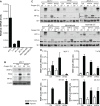Hypoxia-inducible factor-mediated induction of WISP-2 contributes to attenuated progression of breast cancer
- PMID: 27774464
- PMCID: PMC5045054
- DOI: 10.2147/HP.S54404
Hypoxia-inducible factor-mediated induction of WISP-2 contributes to attenuated progression of breast cancer
Abstract
Hypoxia and the hypoxia-inducible factor (HIF) signaling pathway trigger the expression of several genes involved in cancer progression and resistance to therapy. Transcriptionally active HIF-1 and HIF-2 regulate overlapping sets of target genes, and only few HIF-2 specific target genes are known so far. Here we investigated oxygen-regulated expression of Wnt-1 induced signaling protein 2 (WISP-2), which has been reported to attenuate the progression of breast cancer. WISP-2 was hypoxically induced in low-invasive luminal-like breast cancer cell lines at both the messenger RNA and protein levels, mainly in a HIF-2α-dependent manner. HIF-2-driven regulation of the WISP2 promoter in breast cancer cells is almost entirely mediated by two phylogenetically and only partially conserved functional hypoxia response elements located in a microsatellite region upstream of the transcriptional start site. High WISP-2 tumor levels were associated with increased HIF-2α, decreased tumor macrophage density, and a better prognosis. Silencing WISP-2 increased anchorage-independent colony formation and recovery from scratches in confluent cell layers of normally low-invasive MCF-7 cancer cells. Interestingly, these changes in cancer cell aggressiveness could be phenocopied by HIF-2α silencing, suggesting that direct HIF-2-mediated transcriptional induction of WISP-2 gene expression might at least partially explain the association of high HIF-2α tumor levels with prolonged overall survival of patients with breast cancer.
Keywords: invasion; metastasis; motility; oxygen; transcriptional regulation; tumor.
Figures





Similar articles
-
Role of ETS transcription factors in the hypoxia-inducible factor-2 target gene selection.Cancer Res. 2006 Jun 1;66(11):5641-7. doi: 10.1158/0008-5472.CAN-05-3345. Cancer Res. 2006. PMID: 16740701
-
A novel hypoxia response element regulates oxygen-related repression of tissue factor pathway inhibitor in the breast cancer cell line MCF-7.Thromb Res. 2017 Sep;157:111-116. doi: 10.1016/j.thromres.2017.07.013. Epub 2017 Jul 14. Thromb Res. 2017. PMID: 28734156
-
HER2 regulates HIF-2α and drives an increased hypoxic response in breast cancer.Breast Cancer Res. 2019 Jan 22;21(1):10. doi: 10.1186/s13058-019-1097-0. Breast Cancer Res. 2019. PMID: 30670058 Free PMC article.
-
Hypoxia-inducible factor-2alpha correlates to distant recurrence and poor outcome in invasive breast cancer.Cancer Res. 2008 Nov 15;68(22):9212-20. doi: 10.1158/0008-5472.CAN-08-1135. Cancer Res. 2008. PMID: 19010893
-
Hypoxia-inducible factor-1 in human breast and prostate cancer.Endocr Relat Cancer. 2006 Sep;13(3):739-49. doi: 10.1677/erc.1.00728. Endocr Relat Cancer. 2006. PMID: 16954428 Review.
Cited by
-
Microenvironmental Hypoxia Induces Dynamic Changes in Lung Cancer Synthesis and Secretion of Extracellular Vesicles.Cancers (Basel). 2020 Oct 11;12(10):2917. doi: 10.3390/cancers12102917. Cancers (Basel). 2020. PMID: 33050615 Free PMC article.
-
Hypoxic environment may enhance migration/penetration of endocrine resistant MCF7- derived breast cancer cells through monolayers of other non-invasive cancer cells in vitro.Sci Rep. 2020 Jan 24;10(1):1127. doi: 10.1038/s41598-020-58055-x. Sci Rep. 2020. PMID: 31980706 Free PMC article.
-
Deficiency of CCN5/WISP-2-Driven Program in breast cancer Promotes Cancer Epithelial cells to mesenchymal stem cells and Breast Cancer growth.Sci Rep. 2017 Apr 27;7(1):1220. doi: 10.1038/s41598-017-00916-z. Sci Rep. 2017. PMID: 28450698 Free PMC article.
-
Identification of Master Regulators Driving Disease Progression, Relapse, and Drug Resistance in Lung Adenocarcinoma.Front Bioinform. 2022 Jan 28;2:813960. doi: 10.3389/fbinf.2022.813960. eCollection 2022. Front Bioinform. 2022. PMID: 36304306 Free PMC article.
-
A reliable set of reference genes to normalize oxygen-dependent cytoglobin gene expression levels in melanoma.Sci Rep. 2021 May 25;11(1):10879. doi: 10.1038/s41598-021-90284-6. Sci Rep. 2021. PMID: 34035373 Free PMC article.
References
LinkOut - more resources
Full Text Sources
Other Literature Sources

